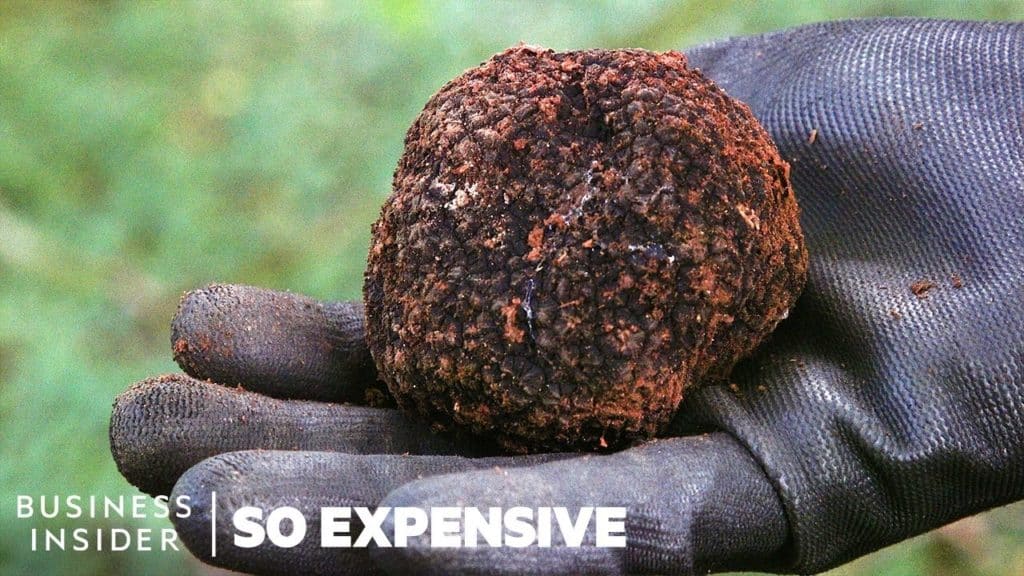Luxury cousins of the mushroom, truffles are an indulgent food enjoyed across the world. But these fragrant fungi will cost you. In 2014, the world’s largest white truffle was flown to New York accompanied by a security guard and sold at auction for $61,000. Discovered in Italy, this gigantic fungus weighed almost 2 kilos. So, what is it that makes them so expensive?
There are a lot of types of truffle. There are at least 40 species, many of which aren’t edible, and new species have been discovered as recently as 2018.
You’ve probably seen luxury truffle products in supermarkets or fancy restaurants, but the unique truffle flavor you recognize might not be real truffle at all. Cheap truffle oil often hasn’t been anywhere near a real truffle. Many cheaper truffle products use 2,4-dithiapentane, a synthesized compound containing one of the main aromatic components of foot odor, guaranteed to give it that „earthy“ taste.
Real truffles are seasonal and pricey, with a short shelf life. They were originally sniffed out using truffle pigs, but while pigs are very good at finding truffles, they’re also very good at eating them, too. And these days, dogs are much more common truffle-hunting companions. These fungi can be found across the world, but they all require a very specific climate to grow. While different varieties may have somewhat different requirements, one thing is certain.
You can’t have truffles without trees. James Feaver: Truffles are always found with trees, and they have to be the right type of trees. Under the ground, the truffle is just the fruiting body, so an equivalent to an apple. And we’ve also got a lot of then what we call the mycelium, microscopic-level threads, and up to 100 meters in a teaspoon of soil.
And this mycelium is actually attached to the roots of a tree like the fingers of glove onto a hand.
And it sort of extends the reach of the tree out. And it actually takes up water and nutrients and passes them to the tree, and the tree gives it sugars in return, so to help the truffles, the fruit, develop. Narrator: Even when you have exactly the right conditions, truffles aren’t guaranteed, and hunting them is a labor-intensive process. Once you know where to look, you have to sniff out and dig up each truffle by hand, and they can be tricky to find.
So he just told us there it’s still in the ground. So do I want to take it out of the ground or not? It all depends on if it’s ripe. If it’s unripe, there’s no point in having it. So the nose comes into play.
And we actually sniff the ground for it. Narrator: It may take a while, but finding a good one can make it worth the work. Feaver: Yeah, that’s a nice one. Yeah, that’s probably about 70, 80 grams. Narrator: Truffles also have a short season, often appearing for only a few months of the year.
And even when you do get your hands on them, they don’t last for long. Feaver: An unripe truffle, unlike a tomato, which you could cut from the vine and ripen on your windowsill, once the truffle is out of the ground, the clock is ticking. So it’s just sort of slowly gonna degrade over time.
So we want to get it out to the customers nice and fast. Narrator: After just five days out of the ground, that pungent truffle smell will have halved.
You can farm many truffle varieties, besides the rare Italian whites. Many people have been successful in setting up truffle orchards, but it’s not easy. Trees need to be planted in the right soil conditions, inoculated with truffle fungus, and often irrigated constantly. It can take as long as six years before you get a good truffle harvest, and there’s no guarantee that the fungi will grow at all. So after all that effort, what do they actually taste like?
Ju Shardlow: Ooh. Claudia Romeo: Hm. Leon Siciliano: The smell just made me think it was gonna be really strong. The flavor is actually quite subtle. There’s a nuttiness there.
There’s, like, an earthy flavor there. Ju: Actually quite light and fragrant.
It tastes a lot nicer than it smells. It smells like damp socks. Claudia: That’s good.
I mean, this is the first time I’ve actually eaten a truffle by itself. You know, it’s a bit like mushroom, but it’s more of a meaty, meaty bite. Narrator: These days, farming has taken over as our primary source of truffles, and today, 70% of the world’s truffles are cultivated. Through the loss of woodland and climate change, the number of wild truffles has decreased significantly. Since the 19th century, production in France has fallen from over 1,000 tonnes a season to just 30 tonnes.
And climate change could mean that truffles will disappear altogether in the future. Feaver: The weather conditions are so important, not just immediately, over the whole season. We’re getting much lower numbers and much lower average size. A truffle is about 70% water, so it needs rainfall to help it grow. Some UK truffle scientists are thinking that your traditional areas, the climate is gonna move further north, and they’re not gonna have a truffle industry within I think perhaps 50 years.
Read More: Tag 1 – Feng Shui anwenden I Grundlagen und Einführung, mit Ute Riedlinger

